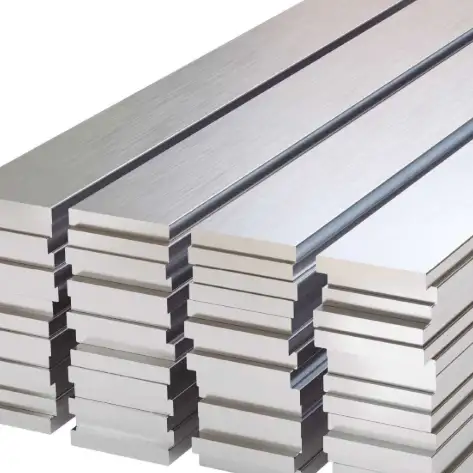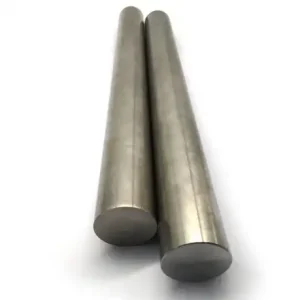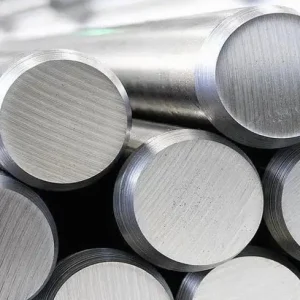2207 stainless steel flat bar is a super-duplex stainless grade commonly specified where a combination of very high strength and excellent resistance to chloride pitting / crevice corrosion is required; it typically contains ~25% Cr, ~7% Ni, ~3–4% Mo and an elevated nitrogen level (~0.25–0.35%), giving yield strengths in the 500–700 MPa range and a PREN (pitting resistance equivalent number) above ~40 — materially outperforming 316 in chloride environments and offering measurable advantage over 2205 for aggressive seawater or chemical service.
What is 2207 material?
“2207” is used commercially to denote a super-duplex / high-alloy duplex stainless steel formulation positioned between standard duplex (2205 family) and the higher-alloy super/hyper duplex families (2507, 2707, etc.). These alloys were developed to combine: higher chromium and molybdenum for improved pitting resistance, elevated nitrogen for strength and pitting resistance, and controlled nickel for toughness. Industry technical summaries list 2207 as belonging to the super-duplex category with PREN values typically around the low-40s, making it suitable for seawater, desalination, chemical processing and some subsea hardware.
Typical chemical composition (recommended mill ranges)
Below is a practical composition table for commercial 2207 / super-duplex 2207 used by mills and stockholders. Because “2207” is a commercial grade name (mild vendor variation exists), always confirm exact mill certificate (MTC) values on the order.
| Element | Typical range (wt%) |
|---|---|
| Carbon (C) | ≤ 0.03 |
| Chromium (Cr) | 24.0 – 26.0 |
| Nickel (Ni) | 6.0 – 8.0 |
| Molybdenum (Mo) | 3.0 – 4.0 |
| Nitrogen (N) | 0.20 – 0.35 |
| Manganese (Mn) | ≤ 1.20 |
| Silicon (Si) | ≤ 0.80 |
| Phosphorus (P) | ≤ 0.035 |
| Sulfur (S) | ≤ 0.020 |
| Copper (Cu) | ≤ 0.50 (typical trace) |
| Iron (Fe) | Balance |
Notes on table: the ranges above are consistent with super-duplex style chemistries published in industry technical summaries and supplier datasheets; the N content and Mo are the most important drivers of PREN and pitting resistance.
Why those elements matter (short):
-
Cr (chromium): forms passive film — higher Cr increases general corrosion resistance.
-
Mo (molybdenum): raises pitting and crevice corrosion resistance in chlorides.
-
Ni (nickel): stabilizes austenite and improves toughness.
-
N (nitrogen): increases yield strength and improves pitting resistance dramatically (high value is a key differentiator of modern super-duplex).
-
C, P, S: minimized to avoid sensitization, intermetallics, and poor weldability.
Mechanical properties and typical specifications
Commercial 2207 flat bar (solution-annealed) will typically deliver the following mechanical performance range (mill-certified minimums differ by supplier and product form):
| Property | Typical minimum (solution annealed) |
|---|---|
| 0.2% proof (yield) strength | ~ 500 – 650 MPa |
| Tensile strength (Rm) | ~ 780 – 980 MPa |
| Elongation (A%) | 15–25% |
| Hardness (Brinell) | ≤ 290 HB (varies by product) |
| Density | ~ 7.85 g/cm³ |
These numbers make 2207 substantially stronger than common austenitic grades (304/316) and somewhat higher than 2205; super-duplex designs trade a degree of formability for much higher strength and pitting resistance. For pipe and tube Alleima / Sandvik datasheets for super-duplex grades show the same trend of elevated strength and high CPT (critical pitting temperature).
Applicable purchaser specifications (typical):
-
ASTM A276 — stainless steel bars and shapes (common for flat bars when ordered in bar form).
-
ASME/ASTM A240 (ASME SA-240) — plate & sheet specification that stockists reference for flat product.
-
For pressure or tube applications, mills will reference UNS numbers and EN numbers where relevant — always confirm the exact specification on the PO.
Which is better: 2207 vs 2205 vs 316?
The best choice depends on the environment and cost target:
-
2207 vs 316: in chloride-containing aqueous environments (seawater, brine, desalination), 2207 is a clear technical winner. 316 is an austenitic general-purpose grade with low cost and good formability; however, in high chloride or high temperature chloride service it is prone to pitting and stress corrosion cracking where 2207 will last much longer. For pressure-critical, thin-walled designs where weight matters, 2207’s higher yield strength can allow thinner sections.
-
2207 vs 2205: 2205 is a very successful duplex grade (UNS S31803 / S32205) with balanced strength and corrosion resistance. 2207 is generally formulated with higher Cr/Mo/N and targets super-duplex performance — higher PREN, higher yield and higher CPT. Choose 2207 when the service is more aggressive (higher chloride content, higher temperatures, or where higher mechanical margins are required). Choose 2205 when the environment is moderate and cost and weldability are higher priorities.
Engineering rule-of-thumb: if the design’s CPT requirement or PREN target is ≥40, or there is known aggressive chloride chemistry, super-duplex (2207/2507) should be evaluated; if CPT/PREN requirements are lower and cost is a constraint, 2205 often suffices.
What is 2207 stainless steel equivalent to?
“2207” is a commercial grade name and can have slight vendor variations. Buyer caution: mills and stockists sometimes map 2207 to super-duplex UNS grades or their own trade names. Some vendors list UNS S32207 as associated with 2207, and academic/industry reports reference UNS S32207 in comparative corrosion testing; others treat 2207 as essentially a super-duplex in the same class as UNS S32750 family items — therefore always ask for a mill test certificate (MTC) and the exact UNS/EN number before acceptance. The recent literature and vendor pages show that UNS S32207 is being used in commercial practice and that S32207 can show superior corrosion behavior vs S32205 in some studies; check the MTC to confirm exact chemistry.
Buyer checklist for equivalence: require the seller to provide:
-
Full MTC (chemical analysis + heat treat condition)
-
Stated UNS/EN/WERKSTOFF number (if any)
-
Mill heat/traceability and standard to which the material is furnished (ASTM A276, ASME SA-240, EN 10088 etc.)
-
Certificate that lists N, Mo, Cr, Ni contents (N is particularly important for duplex family).
Flat bar grade selection, tolerances and standards
-
Common shop specs for flat bar: ASTM A276 (bars), ASME SA-240 / ASTM A240 (plates/sheets). Specifying engineers should state both grade name (e.g., 2207) and required standard plus heat treatment and any surface finish/flattening requirements.
-
Mill tolerances & finishes: hot-rolled solution annealed, cold-finished bright, mill-straightened; typical finishes: 2B, No.4.
-
Welding consumables: for welding 2207 to itself or to other duplex grades, use matched super-duplex filler wires (consult mill datasheets and welding supplier guidance).
Sizes and weight (how to calculate)
How to calculate weight per meter for flat bar:
weight (kg/m) = width (mm) × thickness (mm) × density (kg/m³) ÷ 1,000,000.
Use density = 7,850 kg/m³ (typical for stainless steels). Example: a 50 mm × 12 mm flat bar → area = 600 mm² → weight = 600 × 7,850 ÷ 1,000,000 = 4.710 kg/m.
I computed a set of common sizes and exact weights (kg/m and kg/ft). The interactive table is displayed for you (accurate to three decimals). The table shown from the calculation engine includes these rows:
For convenience the rows are:
| Width (mm) | Thickness (mm) | Area (mm²) | Weight (kg/m) | Weight (kg/ft) |
|---|---|---|---|---|
| 10 | 3 | 30 | 0.236 | 0.773 |
| 12 | 4 | 48 | 0.377 | 1.236 |
| 20 | 5 | 100 | 0.785 | 2.575 |
| 25 | 6 | 150 | 1.178 | 3.863 |
| 30 | 8 | 240 | 1.884 | 6.181 |
| 40 | 10 | 400 | 3.140 | 10.302 |
| 50 | 12 | 600 | 4.710 | 15.453 |
| 75 | 15 | 1125 | 8.831 | 28.974 |
| 100 | 20 | 2000 | 15.700 | 51.509 |
Use the formula above for any custom dimension. Always allow for cutting losses and mill tolerances when planning weight to cost.
Global price — 2025 indicative comparison
Important: stainless and super-duplex prices fluctuate with nickel, moly and chromium markets and with regional supply/demand; the figures below are indicative spot ranges observed in 2025 and should be confirmed with live quotes and freight/insurance/duties.
| Region | Typical 2207 / super-duplex price (indicative) |
|---|---|
| China (domestic ex-works) | US$ 1,200 – 2,800 / tonne (wide range; small orders at higher end). |
| India (domestic mills / stockists) | US$ 1,300 – 3,000 / tonne (varies by product form, pipe vs bar). |
| Europe (spot, MEPS indexes) | ~US$ 2.5 – 4.5 / kg (i.e. US$ 2,500 – 4,500 / tonne) depending on alloy and form. MEPS monthly series shows stainless index movements in early 2025 around these levels. |
| North America | Similar to Europe (regional premiums apply) — expect US$ 2,500 – 5,000 / tonne depending on inventory, customs and logistics. |
How to use these ranges: when you compare quotes, always parse the total landed cost (price + freight + duty + testing + cutting) and compare kg or tonne on identical product condition (solution-annealed flat bar vs bright bar vs plate). Small orders incur machining / processing premiums.
Corrosion, welding and fabrication
-
Welding: duplex and super-duplex require matched-composition filler metals and controlled heat input to maintain desirable austenite/ferrite balance — follow mill recommendations and welding supplier datasheets. Post-weld solution annealing is sometimes required for critical components.
-
Heat input & intermetallics: avoid excessive heat cycles and long dwell at 600–1000°C; that range promotes sigma/chi phase formation, which lowers toughness and localized corrosion resistance. Use appropriate cooling and post-weld heat treatment if required.
-
Passivation: after fabrication, chemical pickling or passivation (e.g., citric / nitric pickling per spec) improves surface film and pitting resistance. Follow cleaning and passivation standards recommended for duplex steels.
-
Machining: higher strength requires robust tooling; cutting parameters differ from 316 — expect lower MRR (material removal rates) and different insert grades.
-
Inspection: request CPT (critical pitting temperature) or pitting/crevice corrosion test results for high-risk projects; weld coupons should be tested where service is aggressive.
MWAlloys commercial note (how MWAlloys can serve you)
MWAlloys is a China-based metals supplier and manufacturer focusing on high-performance stainless and duplex alloys. For 2207 stainless flat bar we offer:
-
Factory direct pricing (100% mill-to-buyer channel where possible).
-
Stock availability of common flat bar sizes for rapid shipment.
-
Custom cutting, cold finishing and mill testing as requested.
-
Competitive lead times from our warehouses in China for standard sizes; for large/critical orders we provide full MTC and test reports.
If you require price, please specify: dimension (width × thickness × length), surface finish, required standard (ASTM A276 / ASME SA-240 or equivalent), quantity and destination port — MWAlloys will respond with an itemized ex-works and CIF offer.
FAQs
-
What is 2207 used for?
High-strength, chloride-rich applications: seawater heat exchangers, desalination, subsea components, chemical process equipment. -
Is 2207 magnetic?
Duplex and super-duplex have a mixed austenite/ferrite microstructure — they can show slight magnetic response (not as strongly magnetic as ferritic steels), especially in the ferritic phase and cold-worked parts. -
Can 2207 be welded to 316?
Yes, but use matched or transition filler metals and check dilution effects. Welding duplex to austenitic requires filler selection to avoid excessive ferrite or intermetallics; consult welding supplier and perform qualified procedure. -
What is PREN and why does it matter?
PREN (Pitting Resistance Equivalent Number) is a calculation that estimates resistance to pitting corrosion: PREN ≈ %Cr + 3.3×%Mo + 16×%N. Higher PREN implies better pitting resistance (2207 PREN typically ≥40). -
Is 2207 stronger than 2205?
Typically yes — 2207 formulations are designed for higher yield/tensile strength than standard 2205. Confirm on the MTC. -
What mill certificates should I request?
Request full MTC showing chemical analysis (with N), mechanical test results, heat number, and applicable standards referenced. -
Can I cold-bend 2207 flat bar?
Small bends are possible, but due to higher strength and lower ductility vs 316, larger or tight radius bends may need annealing or hot forming. -
How to specify 2207 on PO to avoid ambiguity?
Include: “2207 (super-duplex), mill X trade name if known, required UNS/EN if available, ASTM A276 or ASME SA-240 as applicable, solution-annealed condition, MTC required.” -
Is 2207 cheaper than 2507?
Often yes — 2507 (UNS S32750) typically has slightly higher alloy content (and PREN) and commands a price premium; the gap depends on market for Ni and Mo. -
Where to run corrosion testing?
Use accredited labs for CPT, electrochemical testing and crevice corrosion testing; for critical service, require lab test reports on weld beads and base metal.





